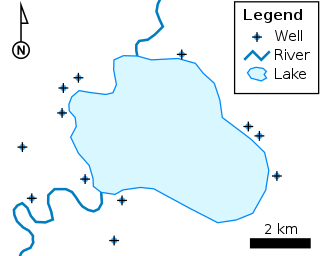Related Research Articles

Esri is an international supplier of geographic information system (GIS) software, web GIS and geodatabase management applications. The company is headquartered in Redlands, California.
A coverage is the digital representation of some spatio-temporal phenomenon. ISO 19123 provides the definition:
A GIS file format is a standard of encoding geographical information into a computer file. They are created mainly by government mapping agencies or by GIS software developers.
GeoTIFF is a public domain metadata standard which allows georeferencing information to be embedded within a TIFF file. The potential additional information includes map projection, coordinate systems, ellipsoids, datums, and everything else necessary to establish the exact spatial reference for the file. The GeoTIFF format is fully compliant with TIFF 6.0, so software incapable of reading and interpreting the specialized metadata will still be able to open a GeoTIFF format file.
A GIS software program is a computer program to support the use of a geographic information system, providing the ability to create, store, manage, query, analyze, and visualize geographic data, that is, data representing phenomena for which location is important. The GIS software industry encompasses a broad range of commercial and open-source products that provide some or all of these capabilities within various information technology architectures.

The shapefile format is a geospatial vector data format for geographic information system (GIS) software. It is developed and regulated by Esri as a mostly open specification for data interoperability among Esri and other GIS software products. The shapefile format can spatially describe vector features: points, lines, and polygons, representing, for example, water wells, rivers, and lakes. Each item usually has attributes that describe it, such as name or temperature.
Pennsylvania Spatial Data Access (PASDA) is Pennsylvania's official public access geospatial information clearinghouse. PASDA serves as Pennsylvania's node on the National Spatial Data Infrastructure (NSDI). PASDA is a cooperative effort of the Pennsylvania Geospatial Technologies Office of the Office of Information Technology and the Pennsylvania State University Institutes of Energy and the Environment (PSIEE).

The Geospatial Data Abstraction Library (GDAL) is a computer software library for reading and writing raster and vector geospatial data formats, and is released under the permissive X/MIT style free software license by the Open Source Geospatial Foundation. As a library, it presents a single abstract data model to the calling application for all supported formats. It may also be built with a variety of useful command line interface utilities for data translation and processing. Projections and transformations are supported by the PROJ library.
GeoPDF refers to map and imagery products created by TerraGo software applications. GeoPDF products use geospatial PDF as a container for maps, imagery, and other data used to deliver an enhanced user experience in TerraGo applications. However, GeoPDF products conform to published specifications including both the OGC best practice for PDF georegistration as well as Adobe's proposed geospatial extensions to ISO 32000, making them readable by applications such as Adobe Acrobat, Adobe Reader, Avenza PDF Maps, Global Mapper, and others. GeoPDF products often include other advanced PDF features such as layers and object data which can add significant GIS functionality to the file, particularly when used with the TerraGo Technologies plugin to Adobe Reader or other TerraGo clients.
Geospatial metadata is a type of metadata applicable to geographic data and information. Such objects may be stored in a geographic information system (GIS) or may simply be documents, data-sets, images or other objects, services, or related items that exist in some other native environment but whose features may be appropriate to describe in a (geographic) metadata catalog.
A spatial data infrastructure (SDI) is a data infrastructure implementing a framework of geographic data, metadata, users and tools that are interactively connected in order to use spatial data in an efficient and flexible way. Another definition is "the technology, policies, standards, human resources, and related activities necessary to acquire, process, distribute, use, maintain, and preserve spatial data".
Map database management systems are software programs designed to efficiently store and recall spatial information. They are widely used in localization and navigation, especially in automotive applications. Moreover, they are playing an increasingly important role in the emerging areas of location-based services, active safety functions and advanced driver-assistance systems. Common to these functions is the requirement for an on-board map database that contains information describing the road network.
A geoportal is a type of web portal used to find and access geographic information and associated geographic services via the Internet. Geoportals are important for effective use of geographic information systems (GIS) and a key element of Spatial Data Infrastructure (SDI).

Metadata is "data that provides information about other data", but not the content of the data, such as the text of a message or the image itself. There are many distinct types of metadata, including:
The Wind ENergy Data and Information (WENDI) Gateway was established by the Environmental Sciences Division of Oak Ridge National Laboratory in March 2010 to support the United States Department of Energy's Wind and Hydropower Technologies Program. It provided a digital library for wind energy-related data and information from a wide spectrum of sources—including data centers, scientific and technical journals, and geographic information systems (GIS), as well as the websites of government agencies, corporations and trade organizations. The gateway was taken offline after funding ended in August 2012. Much of its content was incorporated into the OpenEI site.
The Spatial Archive and Interchange Format was defined in the early 1990s as a self-describing, extensible format designed to support interoperability and storage of geospatial data.
Geographic information systems (GIS) play a constantly evolving role in geospatial intelligence (GEOINT) and United States national security. These technologies allow a user to efficiently manage, analyze, and produce geospatial data, to combine GEOINT with other forms of intelligence collection, and to perform highly developed analysis and visual production of geospatial data. Therefore, GIS produces up-to-date and more reliable GEOINT to reduce uncertainty for a decisionmaker. Since GIS programs are Web-enabled, a user can constantly work with a decision maker to solve their GEOINT and national security related problems from anywhere in the world. There are many types of GIS software used in GEOINT and national security, such as Google Earth, ERDAS IMAGINE, GeoNetwork opensource, and Esri ArcGIS.

The Open Geospatial Consortium (OGC), an international voluntary consensus standards organization, originated in 1994. In the OGC, more than 500 commercial, governmental, nonprofit and research organizations collaborate in a consensus process encouraging development and implementation of open standards for geospatial content and services, sensor web and Internet of Things, GIS data processing and data sharing.
In computing, a data definition specification (DDS) is a guideline to ensure comprehensive and consistent data definition. It represents the attributes required to quantify data definition. A comprehensive data definition specification encompasses enterprise data, the hierarchy of data management, prescribed guidance enforcement and criteria to determine compliance.
A GeoPackage (GPKG) is an open, non-proprietary, platform-independent and standards-based data format for geographic information system implemented as a SQLite database container. Defined by the Open Geospatial Consortium (OGC) with the backing of the US military and published in 2014, GeoPackage has seen widespread support from various government, commercial, and open source organizations.
References
- ↑ Federal Geographic Data Committee. FGDC-STD-001-1998. Content standard for digital geospatial metadata (revised June 1998). Federal Geographic Data Committee. Washington, D.C. Available on-line
- ↑ Goodchild, M.F., and K.K. Kemp, eds. 1990. NCGIA Core Curriculum in GIS. National Center for Geographic Information and Analysis, University of California, Santa Barbara CA.
- ↑ Standard Interchange Format (SIF), Navteq, Chicago, Ill, http://www.navteq.com/
- ↑ BOREAS Staff. 2000. Vector Topographic Map Data over the NSA and SSA in SIF Format. Data set. Available on-line from Oak Ridge National Laboratory Distributed Active Archive Center, Oak Ridge, Tennessee, U.S.A.
- ↑ "Is a Standard Terrain Data Format Necessary?" Sabrina Sestito and David Marlow : Air Operations Division, DSTO, PO Box 4331, Melbourne Vic 3001, Australia available online at